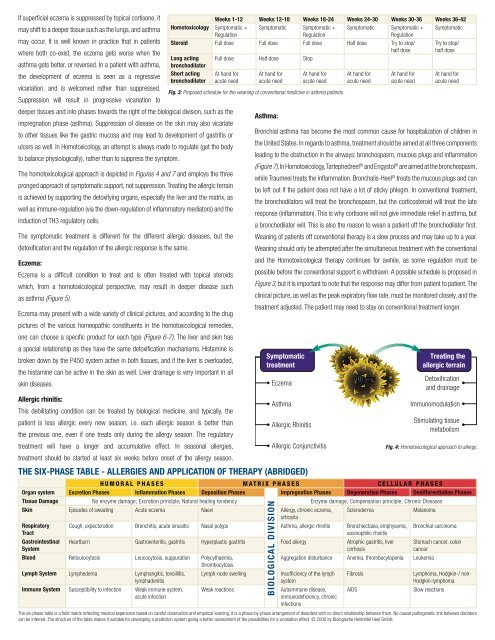allergy indications - Heel BHI
allergy indications - Heel BHI
allergy indications - Heel BHI
Create successful ePaper yourself
Turn your PDF publications into a flip-book with our unique Google optimized e-Paper software.
If superficial eczema is suppressed by topical cortisone, it<br />
may shift to a deeper tissue such as the lungs, and asthma<br />
may occur. It is well known in practice that in patients<br />
where both co-exist, the eczema gets worse when the<br />
asthma gets better, or reversed. In a patient with asthma,<br />
the development of eczema is seen as a regressive<br />
vicariation, and is welcomed rather than suppressed.<br />
Suppression will result in progressive vicariation to<br />
deeper tissues and into phases towards the right of the biological division, such as the<br />
impregnation phase (asthma). Suppression of disease on the skin may also vicariate<br />
to other tissues like the gastric mucosa and may lead to development of gastritis or<br />
ulcers as well. In Homotoxicology, an attempt is always made to regulate (get the body<br />
to balance physiologically), rather than to suppress the symptom.<br />
The homotoxicological approach is depicted in Figures 4 and 7 and employs the three<br />
pronged approach of symptomatic support, not suppression. Treating the allergic terrain<br />
is achieved by supporting the detoxifying organs, especially the liver and the matrix, as<br />
well as immune-regulation (via the down-regulation of inflammatory mediators) and the<br />
induction of TH3 regulatory cells.<br />
The symptomatic treatment is different for the different allergic diseases, but the<br />
detoxification and the regulation of the allergic response is the same.<br />
eczema:<br />
Eczema is a difficult condition to treat and is often treated with topical steroids<br />
which, from a homotoxicological perspective, may result in deeper disease such<br />
as asthma (Figure 5).<br />
Eczema may present with a wide variety of clinical pictures, and according to the drug<br />
pictures of the various homeopathic constituents in the homotoxicological remedies,<br />
one can choose a specific product for each type (Figure 6-7). The liver and skin has<br />
a special relationship as they have the same detoxification mechanisms. Histamine is<br />
broken down by the P450 system active in both tissues, and if the liver is overloaded,<br />
the histamine can be active in the skin as well. Liver drainage is very important in all<br />
skin diseases.<br />
allergic rhinitis:<br />
This debilitating condition can be treated by biological medicine, and typically, the<br />
patient is less allergic every new season, i.e. each allergic season is better than<br />
the previous one, even if one treats only during the <strong>allergy</strong> season. The regulatory<br />
treatment will have a longer and accumulative effect. In seasonal allergies,<br />
treatment should be started at least six weeks before onset of the <strong>allergy</strong> season.<br />
asthma:<br />
The six-phase Table - allergies and applicaTion of Therapy (abridged)<br />
Bronchial asthma has become the most common cause for hospitalization of children in<br />
the United States. In regards to asthma, treatment should be aimed at all three components<br />
leading to the obstruction in the airways: bronchospasm, mucous plugs and inflammation<br />
(Figure 7). In Homotoxicology, Tartephedreel ® and Engystol ® are aimed at the bronchospasm,<br />
while Traumeel treats the inflammation. Bronchalis-<strong>Heel</strong> ® treats the mucous plugs and can<br />
be left out if the patient does not have a lot of sticky phlegm. In conventional treatment,<br />
the bronchodilators will treat the bronchospasm, but the corticosteroid will treat the late<br />
response (inflammation). This is why cortisone will not give immediate relief in asthma, but<br />
a bronchodilator will. This is also the reason to wean a patient off the bronchodilator first.<br />
Weaning of patients off conventional therapy is a slow process and may take up to a year.<br />
Weaning should only be attempted after the simultaneous treatment with the conventional<br />
and the Homotoxicological therapy continues for awhile, as some regulation must be<br />
possible before the conventional support is withdrawn. A possible schedule is proposed in<br />
Figure 3, but it is important to note that the response may differ from patient to patient. The<br />
clinical picture, as well as the peak expiratory flow rate, must be monitored closely, and the<br />
treatment adjusted. The patient may need to stay on conventional treatment longer.<br />
H u m o r a l P H a s e s m at r i x P H a s e s C e l l u l a r P H a s e s<br />
organ system excretion phases inflammation phases deposition phases impregnation phases degeneration phases dedifferentiation phases<br />
Tissue damage No enzyme damage; Excretion principle; Natural healing tendency Enzyme damage; Compensation principle; Chronic Diseases<br />
skin Episodes of sweating Acute eczema Naevi Allergy, chronic eczema,<br />
urticaria<br />
Scleroderma Melanoma<br />
respiratory<br />
Tract<br />
gastrointestinal<br />
system<br />
Cough, expectoration Bronchitis, acute sinusitis Nasal polyps Asthma, allergic rhinitis Bronchiectasia, emphysema,<br />
eosinophilic rhinitis<br />
Heartburn Gastroenteritis, gastritis Hyperplastic gastritis Food <strong>allergy</strong> Atrophic gastritis, liver<br />
cirrhosis<br />
blood Reticulocytosis Leucocytosis, suppuration Polycythaemia,<br />
thrombocytosis<br />
lymph system Lymphedema Lymphangitis, tonsillitis,<br />
lymphadenitis<br />
immune system Susceptibility to infection Weak immune system,<br />
acute infection<br />
Weeks 1-12 Weeks 12-18 Weeks 18-24 Weeks 24-30 Weeks 30-36 Weeks 36-42<br />
homotoxicology Symptomatic + Symptomatic Symptomatic + Symptomatic Symptomatic + Symptomatic<br />
Regulation<br />
Regulation<br />
Regulation<br />
steroid Full dose Full dose Full dose Half dose Try to stop/ Try to stop/<br />
half dose half dose<br />
long acting<br />
bronchodilator<br />
Full dose Half dose Stop<br />
short acting At hand for At hand for At hand for At hand for At hand for At hand for<br />
bronchodilator acute need acute need acute need acute need acute need acute need<br />
Fig. 3: Proposed schedule for the weaning of conventional medicine in asthma patients.<br />
Symptomatic<br />
treatment<br />
• Eczema<br />
• Asthma<br />
• Allergic Rhinitis<br />
• Allergic Conjunctivitis<br />
Lymph-node swelling Insufficiency of the lymph<br />
system<br />
Weak reactions Autoimmune disease,<br />
immunodeficiency, chronic<br />
infections<br />
Aggregation disturbance Anemia, thrombocytopenia Leukemia<br />
Bronchial carcinoma<br />
Stomach cancer, colon<br />
cancer<br />
Fibrosis Lymphoma, Hodgkin-/ non-<br />
Hodgkin-lymphoma<br />
AIDS Slow reactions<br />
The six-phase table is a field matrix reflecting medical experience based on careful observation and empirical learning. It is a phase-by-phase arrangement of disorders with no direct relationship between them. No causal pathogenetic link between disorders<br />
can be inferred. The structure of the table makes it suitable for developing a prediction system giving a better assessment of the possibilities for a vicariation effect. © 2000 by Biologische Heilmittel <strong>Heel</strong> GmbH.<br />
biological division<br />
Allergy<br />
Treating the<br />
allergic terrain<br />
Detoxification<br />
and drainage •<br />
Immunomodulation •<br />
Stimulating tissue<br />
metabolism •<br />
Fig. 4: Homotoxicological approach to <strong>allergy</strong>.



